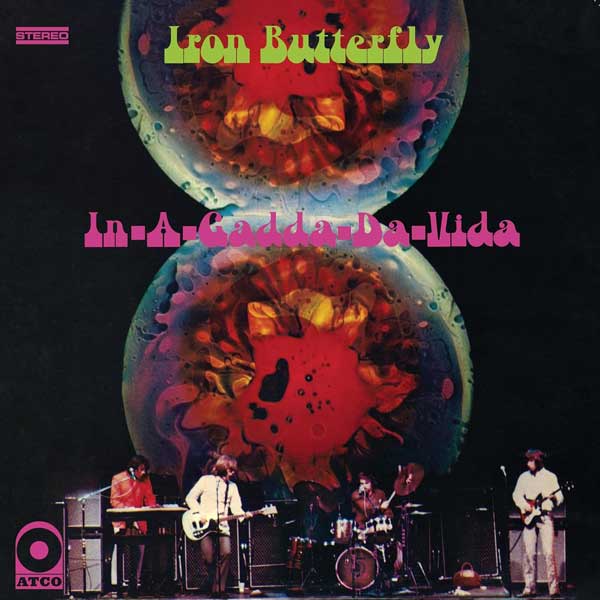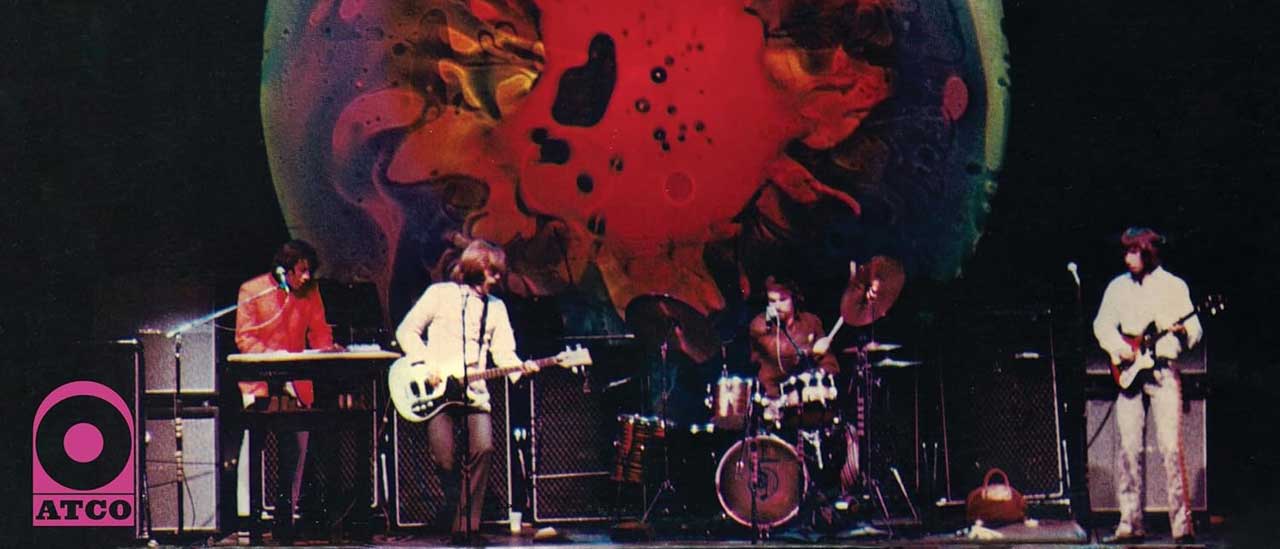
Most Anything You Want
Flowers And Beads
My Mirage
Termination
Are You Happy
In-A-Gadda-Da-Vida
Its “strictly chickenshit” organ may have “bored to death” Rolling Stone in 1968, but Iron Butterfly’s second album In-A-Gadda-Da-Vida was a monster US hit and the first album ever to be certified platinum (for sales of a million copies) in America (it’s now sold 30 million).
The sound of summer 1968, these days its reputation is predicated on the sprawling title track, which takes up the whole of the second side of the vinyl version. A cultural phenomenon, the track is far from the sole positive on an album where dysfunctional psychedelia meets a pumping garage sound – like listening to Led Zeppelin on the wrong drugs.
As the band’s name laboured to suggest, their riffs caught the moment flower-power first flirted with heavy metal. They epitomised the burgeoning counter-culture almost unconsciously. That title track was a studio soundcheck, fortuitously taped while they waited for the producer to arrive, and its refrain a slurred mondegreen.
While its near-gothic meanderings owe a bass-line debt to Cream’s Sunshine Of Your Love, it still prowls and growls with stoner certitude. Often overlooked is the fact that other songs, such as Most Anything You Want and Are You Happy, have a tingle of inspiration too. My Mirage and Flowers And Beads are also effective. The dark side of hippy ideology.

Every week, Album of the Week Club listens to and discusses the album in question, votes on how good it is, and publishes our findings, with the aim of giving people reliable reviews and the wider rock community the chance to contribute.
Other albums released in June 1968
- The Crazy World Of Arthur Brown - The Crazy World Of Arthur Brown
- Bare Wires - John Mayall's Bluesbreakers
- Friends - The Beach Boys
- A Saucerful of Secrets - Pink Floyd
- 40 Blue Fingers, Freshly Packed and Ready to Serve - Chicken Shack
- Children of the Future - Steve Miller Band
- Fairport Convention - Fairport Convention
- It's All About - Spooky Tooth
- Os Mutantes - Os Mutantes
- The Pentangle - Pentangle
- Randy Newman - Randy Newman
- Renaissance - Vanilla Fudge
- Silver Apples - Silver Apples
What they said...
"Iron Butterfly never matched the warped excesses of In-A-Gadda-Da-Vida, either on their debut album of the same name or the rest of their catalogue, yet they occasionally made some enjoyable fuzz guitar-driven psychedelia that works as a period piece. The five tracks that share space with their magnum opus on In-A-Gadda-Da-Vida qualify as good artefacts, and the entire record still stands as the group's definitive album, especially since this is the only place the full-length title track is available." (AllMusic)
"The Iron Butterfly makes dull commercial music, to be blunt and to the point (an odd mixing of metaphors). Doug Ingle (leader, organ and vocals) states that their major influences are themselves and it shows, it shows. Ingle, being their musical leader and director, can be blamed for a great deal. His singing is the most inflexible and sterile I've heard from a major group, and he plays a strictly chicken shit organ." (Rolling Stone)
"It can’t be denied that this album is influential. There is a reason why the major satanic thrash band Slayer used In-A-Gadda-Da-Vida as a live staple. And if you want to get a piece of the late-60s proto-metal action, you are required to at least consider giving Iron Butterfly a listen. In all honesty, this band is no worse than the countless other 60s band that dropped acid and frolicked through the eternal gardens of Eden." (SputnikMusic)
What you said...
Greg Schwepe: As a student of classic rock, I always made it a point to own albums by certain bands that are always noted or listed as something either groundbreaking for their genre, received universal acclaim by critics and fans, or shows up on some “Best Of” type list. Iron Butterfly’s In-A-Gadda-Da-Vida (hereafter referred to as IAGDV because I’m too darned lazy to type it out over and over) was one of those albums. And luckily the bargain bin at Best Buy had a copy of this a couple of years ago, so here was my chance to check out this oft-mentioned 60s album. “OK, I’ll buy it and give it a try…”
Whenever there was an article about late 60’s psychedelic rock, well, there was Iron Butterfly, always in the mix.
Opener Most Anything You Want definitely takes you back to the 60s. Flowers And Beads slowly bounces along with some roller rink organ in the background. After three more tracks (My Mirage, Termination and Are You Happy) we finally get to the main course. Pretty much the reason everyone buys this album.
I’m guessing that Iron Butterfly was not the first psychedelic band to have a long drawn-out jam like IAGDV covering an entire side of vinyl. And yes, the riff is addictive. Get that in your head and it will last for days… well, longer than the 17:04 on the album. And then I kind of lose interest during the looooooong keyboard section in the middle. But the guitar groove kicks back in to ride out the remainder of the song. And we’re done and I realize this album is “well, not as big of a deal as I thought it would be.”
Besides the hypnotic groove in IAGDV, the rest of the album just falls flat. Nothing sticks and many of the songs have enough of the 60s vibe (instrumentation, etc.) that I don’t like. But there are other bands and albums from that same timeframe that are favourites of mine. Go figure.
After seeing IAGDV appear in an episode of The Simpsons where Bart sticks the sheet music for IAGDV into the elderly church organist’s stack of music and the congregation (and the organist) has to endure this extended affair, I kind of feel like they did in the episode when the song ended; “Whew, glad that’s over.” Here was an album I felt I should like, but kind of disappointed that it did not keep my interest.
6 out of 10 for me on this one. And unfortunately, the sale of this CD at the used record/book store probably only netted me about $2. That’s roughly $.11 per minute for the lengthy In-A-Gadda-Da-Vida. Not a fair return!
Mike Canoe: In-A-Gadda-Da-Vida is a bit of a one-trick pony, but - wow - what a trick that pony can do.
Sure, In-A-Gadda-Da-Vida is just over seventeen minutes long but if that was all it had going for it, it would be a musical curiosity and little more.
In-A-Gadda-Da-Vida is powerful and primordial, yet accessible. Even with numerous solos, it never loses its momentum or rhythm. It swings like few songs of its size would want to. It doesn't want to stun you with its tricky time signatures or twiddly bits, it just wants you to ride along and enjoy its massive groove.
Then there's the happy accident of drummer Ron Bushy mishearing songwriter Doug Ingle's lyrics and transcribing the lyrics as In-A-Gadda-Da-Vida instead of In the Garden of Eden. What was essentially gibberish gave the song a cryptic and otherworldly quality.
The other five songs on the album aren't necessarily bad but can't help but lack the impact of the title track. Most Anything You Want and Flowers and Beads are, at their core, syrupy traditional love songs, just decked out in psychedelic duds. My Mirage and Termination are off-brand mysticism but Are You Happy finds the band riding another great, albeit much shorter, groove.
Ultimately a very fun album - even if you just keep coming back for that one epic song.
Mark Herrington: The title track impressed me up to 6:20 in its running time when it sounded like it was naturally closing out - the following 10-plus minutes of it seemed pointless.
If they had repeated the style present in that first six minutes on the other tracks, and developed that theme, this would have been a much better album. Instead, the rest of the tracks were so-so and left no impression.
There were hints of the Idle Race / The Move here and there - but those two bands produced better material than this. Not the album I was expecting: one highlight and the rest a bit nondescript.
Gus Schultz: Definitely a creature of its time. I don’t think any song defines psychedelia like IAGDV, except for perhaps, Incense And Peppermints. This album is definitely the most psychedelic-sounding LP of their career, with each album sounding a little different than the last. It’s a good album but its dated sound is hard for some who don’t really connect with that 60’s southern California hippie scene.
Most of the songs on the album are still listenable today but the organ can get a little overwhelming. The track is definitely a stone-cold classic, worthy of a place in the Smithsonian Institute, or at least in everyone’s album collection. These days I prefer the shorter single release when I need a taste of that classic riff!
Chris Elliott: Once upon a time in my hippy days I really rated the title track - Side 1 was always a bit naff. Now I struggle - my tolerance for drum solos and general noodling reduces with each passing year - the driving hypnotic rhythm is there but it just wanders into self-indulgence for the middle part.
The problem is in the intervening 50-plus years the whole thing has been done better. The lack of mushrooms in my diet may also be a factor (although it doesn't reach the 'WTF was I thinking?'-stage things like Gong now evoke).
Dale Munday: Well, I have given this a really good listening to . My conclusion being that it is mostly awful.
The title track must have been quite, adventurous and radical in 1968 and I would probably have dug it back then man. As a magnum opus it shines quite brightly, and I guess deserves its classic status as one of the earliest side-long pieces of rock music As for the shorter tracks, I found that quite an endurance test that I will never repeat.
Keith Jenkin: I got into this album in the late eighties after the title track was used to soundtrack the great drawn-out scene towards the end of Michael Mann's film Manhunter. The record is split between a side of shorter songs that I think are a good time capsule of when the hippy era was starting to drift towards a harder rock sound but the highlight is obviously the seventeen-minute title track. Its length is key to its success, as it slowly builds in intensity and pulls in the listener, and it's one that I think would certainly appeal to fans of say the more experimental work of early Pink Floyd and even some of the bands like Can from the early German electronic music scene.
Alistair Begg: Excellent album.
Richard Cardenas: Hard to forget this album for me. It’s 10 just because of how significant it was for an era. Just listened to this last week and I still really enjoy it.
Philip Qvist: Of course, I've heard the song In-A-Gadda-Da-Vida countless times, but until now I had never listened to any other Iron Butterfly song; so this album was a bit of a mystery to me.
Doing some research while listening to the album, I found out that the title track was actually a drunken slur of 'In The Garden of Eden', and, although the band is still active, all four musicians on this album are no longer with us.
The recently departed Doug Ingle was clearly the mastermind on this album with his songwriting, his singing and, most importantly of all, his distinctive keyboard playing, but the other members, especially guitarist Erik Brann, also made their contributions.
While I have no issue with the musicianship, I have to admit that the psychedelic genre has never really appealed to me - and so it is the case here. The title track is excellent, if a bit too long (although it probably wasn't the case in the late 60s), while the other five tracks are good and concise without being memorable enough for me.
It is probably a bit unfair for me to give this one a 6/10 knowing the importance of this album when it first came out, but it just didn't appeal to me at all. That said, I do expect many others to give this one very high scores - and probably rightly so.
John Davidson: The title track remains a groovy psychedelic masterpiece driven by its keyboards and baseline, but the rest of the album is largely forgettable.
I'm not sure if this counts as an early venture into prog rock or whether it is 'just' a heavy psychedelic jam, but either way it manages to keep going through a number of 'movements' for most of its 17-plus minutes without overstaying its welcome.
Opener Most Anything You Want is ok, but the rest is so 'hippy dippy' it almost feels like a parody.
Final score: 7.10 (64 votes cast, total score 455)
Join the Album Of The Week Club on Facebook to join in. The history of rock, one album at a time.


